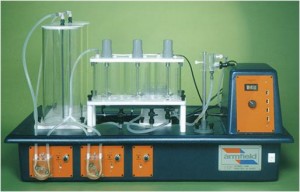This Continuous Stirrer Tank Reactors In Series Project is about Continuous stirrer tank reactors in series which contains pictorial, graphical and Experimental work of Continuous stirrer tank reactors. The report also explains about the Time constant during experiment and calculation of each tank. There are five Experiments explain in the report including Procedure, time constant, Graphical method, calculation of Experiments. The Experiments are Effect of a step input change, Response of tank concentration to an impulse Change, Influence of flow rate on a three tank system following a step change in input concentration,

Response to step change in input concentration of system comprising on one stirred vessel and dead time module, demonstration of the progress of a second order chemical reaction through three continuous stirred tank reactors in series.
The continuous stirred-tank reactor also called vat- or back mix reactor. It is a usual ideal reactor type in chemical engineering. A continuous stirred-tank reactor often pertains to a model used to estimate the key unit operation variables when using a continuous agitated-tank reactor to reach a specified output. The mathematical model acts for all fluids: liquids, gases, and slurries.
Conclusion:
Continuous stirred tank reactors in series have been studied experimentally in detail for their dynamic behavior. By introducing the step and impulse input changes in concentrations and flow rates of reagents, the system is confirmed to be first order. The step and impulse response curves are found to be the sigmoid and exponential respectively. Furthermore, saponification reaction is carried out and the effects of parameters are analyzed using the factorial design of experiments method.
The ‘reagents concentrations’ and ‘system temperature’ effects have been neglected during the analysis for optimization, but these may affect the process response considerably. Taking these into account for optimization of process parameters, one may get more beneficial values of conversion. First two and the third reactors may be connected in parallel, but obviously will have a low performance than the existing ones in series.
Leave a Reply